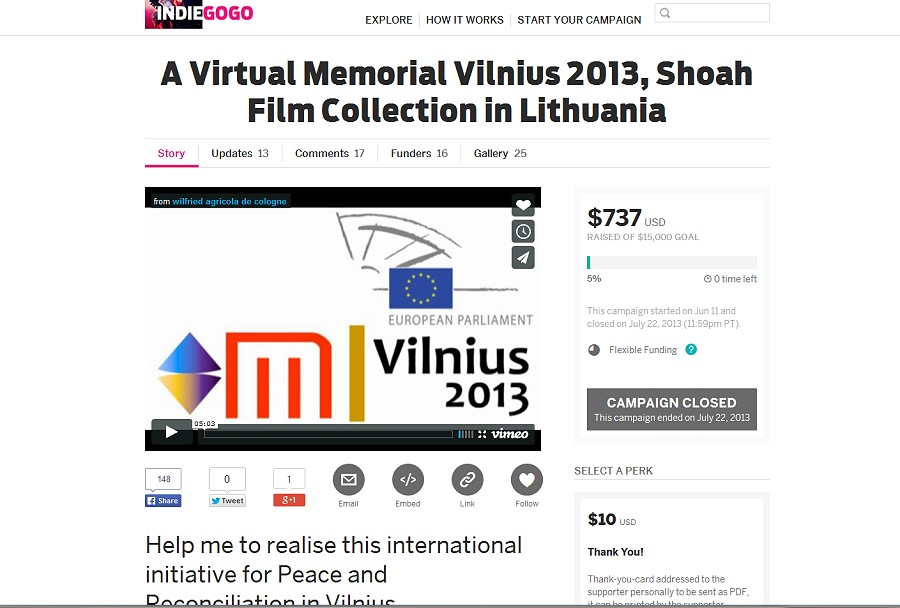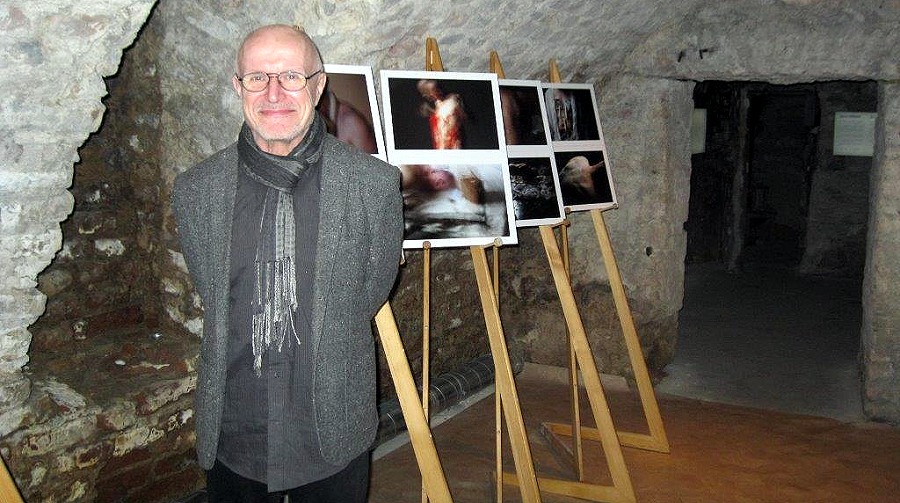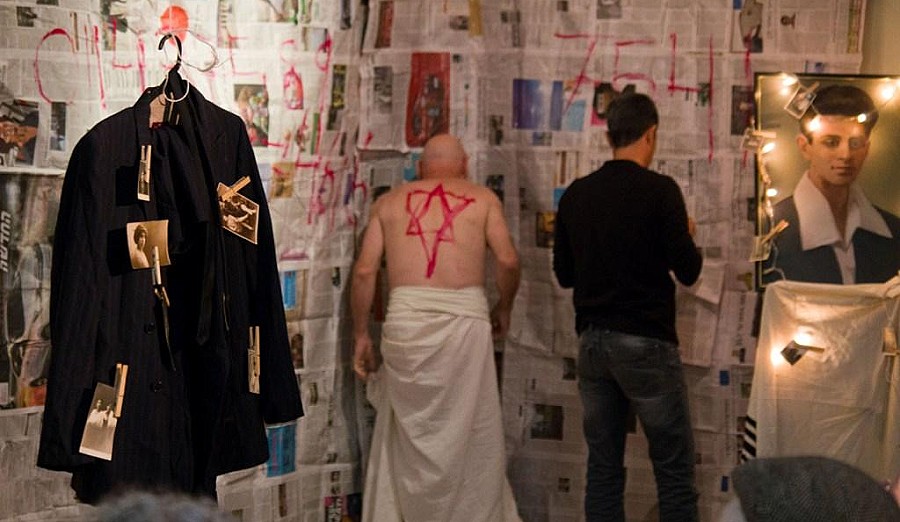The exhibitions (performative interventions) had four components:
![]()
Crowdfunding campaign @ Indigogo
11 June – 22 July 2013
![]()
The exhibition & screenings (23 Sept – 27 Oct 2013)
@ JCIC Vilnius
![]()
Performance Doron Polak (25 September 2013)
@ Tolerance Center/Vilna Gaon State Jewish Museum
![]()
Performance Arturas Bumsteinas (26 September 2013)
@ St. Catherine’s Church
![]()
Exhibition & screening Shoah Film Collection (1 -29 Oct 2013)
@ Kedainiai Regional Museum
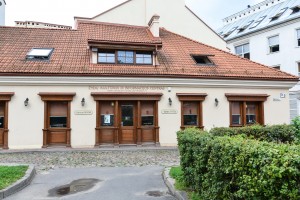 The inauguration was finalized when Agricola de Cologne was inviting the private view visitors to a guided tour through the exhibition installed at the two floors of Jewish Culture and Information Center. As an intervention itself in the frame-work of “A Virtual Memorial Vilnius 2013, the exhibition is consisting of a variety of integrated interventional components, including the representation of
The inauguration was finalized when Agricola de Cologne was inviting the private view visitors to a guided tour through the exhibition installed at the two floors of Jewish Culture and Information Center. As an intervention itself in the frame-work of “A Virtual Memorial Vilnius 2013, the exhibition is consisting of a variety of integrated interventional components, including the representation of 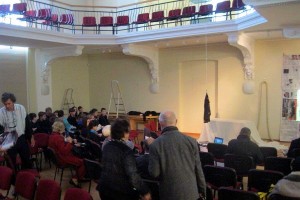 “Shoah Film Collection” & “A Virtual Memorial Vilnius 2013” together with the attending participants. The screenings of the films in Vilnius & Kedainiai have a particular relevance, because a wide range of programs related to collective and individual memory including Shoah Film Collection are presented in Vilnius as the launch of 9th Cologne International Videoart Festival.
“Shoah Film Collection” & “A Virtual Memorial Vilnius 2013” together with the attending participants. The screenings of the films in Vilnius & Kedainiai have a particular relevance, because a wide range of programs related to collective and individual memory including Shoah Film Collection are presented in Vilnius as the launch of 9th Cologne International Videoart Festival. 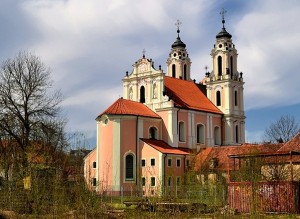 In Vilnius, the screening of the films are complemented by the exhibition of photographs by Eitan Vitkon (Israel) using experimental techniques for visualizing Doron Polak’s Riga performances, prints (Paolo Bonfiglio (italy), Shelley Jordon (USA), Tammy Mike Laufer Israel”, and Grace Graupe Pillard,
In Vilnius, the screening of the films are complemented by the exhibition of photographs by Eitan Vitkon (Israel) using experimental techniques for visualizing Doron Polak’s Riga performances, prints (Paolo Bonfiglio (italy), Shelley Jordon (USA), Tammy Mike Laufer Israel”, and Grace Graupe Pillard, 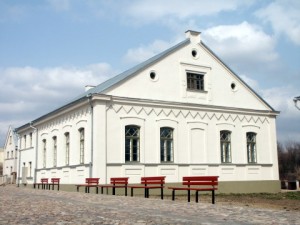 giving the viewer background information about the “making of” of their films included in SFC, and the original installation “Silent Cry” by Wilfried Agricola de Cologne, not to forget the installation of three interactive works by Ariel Yannay-Shani, Joseph Rabie and Agricola de Cologne, running from computers and the 18 screening programs of the entire film collection running on a couple of computers independently from the daily screenings at JCIC Vilnius, but the (visual art) performance by Doron Polak on 25 Sept 2013 and the electro-acoustic performance by Arturas Bumsteinas and Wolumen Trio on 26 Sept. 2013 belongs to that, as well demonstrating how artists using these artistic media for dealing with the remembrance of the Holocaust. In total, a diversity of aspects how artists deal with the topic of Shoah can be experienced by an audience who is curious of the unexpected and not-yet-known.
giving the viewer background information about the “making of” of their films included in SFC, and the original installation “Silent Cry” by Wilfried Agricola de Cologne, not to forget the installation of three interactive works by Ariel Yannay-Shani, Joseph Rabie and Agricola de Cologne, running from computers and the 18 screening programs of the entire film collection running on a couple of computers independently from the daily screenings at JCIC Vilnius, but the (visual art) performance by Doron Polak on 25 Sept 2013 and the electro-acoustic performance by Arturas Bumsteinas and Wolumen Trio on 26 Sept. 2013 belongs to that, as well demonstrating how artists using these artistic media for dealing with the remembrance of the Holocaust. In total, a diversity of aspects how artists deal with the topic of Shoah can be experienced by an audience who is curious of the unexpected and not-yet-known.
This campaing in June/July 2013 has an ambivalent value, it was less successful in the sense, that it did not reach the funding goal, however, it was successful in any other sense. It was a kind of public preview before the actual event in Vilnius was taking place reaching a global audience.
The exhibition as a form of an intervention on location in Vilnius had the meaning to represent the physical conceptual framework of the art work, eg. A Virtual Memorial Vilnius 2013. Although this framework was consisting of several components provided by different creators (artists), it was not an art exhibition in this sense that different artworks by individual artists would have been traditionally installed at an exhibition space. The exhibition had the intention to give background information about “A Virtual Memorial Vilnius 2013” as a kind of community or network based art work, whereby “community” is not only related to the communities of hosts, holders and artists, but basically also the “unknown” component, eg. the audience to be activated. The exhibition had its relevance in representing the conceptual framework as a condition for such a kind of activation. The material presentation of the exhibition was suffering from the lack of funding, but not the concept of the exhibition prepared for a non-art-related space. This space had been transformed into a space of art because the institution hosting the art project of “A Virtual Memorial Vilnius 2013” made the building not only a part of the art project, which became, this way, an object of contemporary art. By being a corporate part of the art project, the place as a reconstructed building was standing for the entire former Ghetto and the Jewish settling area of Vilnius and the entire history of Jewish life starting from the first Jewish settlers centuries ago. For the art project itself, exactly this was the conceptual condition, and this was including also some physical, technical and technological restrictions, which did not make the space a perfect space of art in the sense of a museum or gallery space, but a perfect space in terms how authenticity has been transmitted via reconstructing. Especially the building of the Jewish Culture and Information Center was just generating an image of authenticity and was in this sense, already only virtual, only as an art object, as a part of a superordinated art project it became physically authentic. Probably in whole Vilnius there was no better place for being transformed to “A Virtual Memorial Vilnius 2013”.
![]() Exhibition II (Shoah Film Collection)
Exhibition II (Shoah Film Collection)
![]() Exhibition III – upper & basement gallery
Exhibition III – upper & basement gallery
Performance by Doron Polak @ Tolerance Center/Vilna Gaon State Jewish Museum
Performance – electro-acustic music – Arturas Bumsteinas & Wolumen Trio @ St. Catherine’s Church Vilnius
Arturas Bumšteinas is composer of experimental electronic and acoustic music and sound-artist with projects presented in festival, exhibitions and variuos events all over the world. He is also a founding member of ensembles Quartet Twentytwentyone, Wolumen, Zarasai (with Anton Lukoszevieze), Works & Days. His radiophonic work was awarded the Palma Ars Acustica award by European Broadcasting Union. His music is documented in dozen of releases by various European record labels. He lives in Vilnius and Berlin.
Wolumen Trio
Arturas Bumšteinas – synthesizers, idea
Dominykas Vyšniauskas – trumpet, shofar
Kamil Szuszkiewicz – trumpet, shofar
Wolumen Trio play music inspired by “Musikaliszer Pinkos”
(A.M.Berenstein 1927, Wilna)
Wolumen Trio play music inspired by “Musikaliszer Pinkos” – a collection of more than two hundred Hebrew religious hymns and Chassidic songs compiled and published by A.M.Berenstein in the year 1927 in Wilna. The selection of songs from “Musikaliszer Pinkos” is being re-constructed by Wolumen Trio in a new context of electronic art-music and free improvisation. The concert is presented as a 6-channel surround situation which enables audience members to immerse themselves into the minute details of melody and harmony. Duration of the whole concert is around one hour.
http://www.refusenik.org/works-by-year/2013-2/musikaliszer-pinkos/
Exhibition @ screening of Shoah film Collection and Collective Trauma Film Collections in Kedainiai


